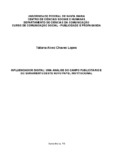| dc.contributor.advisor | Petermann, Juliana | |
| dc.creator | Lopes, Tatiana Alvez Chaves | |
| dc.date.accessioned | 2019-08-08T13:28:05Z | |
| dc.date.available | 2019-08-08T13:28:05Z | |
| dc.date.issued | 2018-07-06 | |
| dc.date.submitted | 2018 | |
| dc.identifier.citation | LOPES, T. A. C. Influenciador digital: uma análise do campo publicitário e do surgimento deste novo papel institucional. 2018. 70 p.
Trabalho de Conclusão de Curso (Graduação em Publicidade e Propaganda) - Universidade Federal de Santa Maria, Santa Maria, RS, 2018. | por |
| dc.identifier.uri | http://repositorio.ufsm.br/handle/1/17808 | |
| dc.description | Trabalho de conclusão de curso (graduação) - Universidade Federal de Santa Maria, Centro de Ciências Sociais e Humanas, Curso de Comunicação Social - Publicidade e Propaganda, RS, 2018. | por |
| dc.description.abstract | The present research seeks to understand the changes in the advertising field through the emergence of digital influencer. Based on this approach, we defined our research problem as: what are the main factors established in the advertising field in view of the emergence of a new institutional role: the digital influencer? To answer this question, we traced as general objetive of this study to investigate the changes in the advertising field in view of
the relation established between agencies and digital influencers, which present themselves as a new institutional role. As specific objectives, we highlight: Outline the contours of the definition of this new institutional role of the advertising field: the digital influencer; Ponder the credibility and persuasion power of digital influencers based on Bourdieu’s concept of social capital; Verify the existing ethical implications in the advertising field from the emergence of digital influencers. The method chosen to conduct
our research was cartography, with focus on Kastrup’s “attention operation” (2007), which we aligned with our objetives and research object. To support our work theoretically, we used Bourdieu’s concepts of field and social capital (2005; 1998) and institutionalization by Berger & Luckmann (1985). Based on these conceptions, we were able to understand the changes in the advertising field as well as identify the definitions of digital influencer. | eng |
| dc.language | por | por |
| dc.publisher | Universidade Federal de Santa Maria | por |
| dc.rights | Acesso Aberto | por |
| dc.rights.uri | http://creativecommons.org/licenses/by-nc-nd/4.0/ | * |
| dc.subject | Campo publicitário | por |
| dc.subject | Influenciador digital | por |
| dc.subject | Papel institucional | por |
| dc.subject | Capital social | por |
| dc.subject | Advertising field | eng |
| dc.subject | Digital influencer | eng |
| dc.subject | Institutional role | eng |
| dc.subject | Social capital | eng |
| dc.title | Influenciador digital: uma análise do campo publicitário e do surgimento deste novo papel institucional | por |
| dc.title.alternative | Digital influencer: an analysis of the advertising field and of the emergence of this new institutional role | eng |
| dc.type | Trabalho de Conclusão de Curso de Graduação | por |
| dc.degree.local | Santa Maria, RS, Brasil | por |
| dc.degree.graduation | Comunicação Social - Publicidade e Propaganda | por |
| dc.description.resumo | A presente pesquisa busca compreender as alterações no campo publicitário com o surgimento do influenciador digital. A partir dessa abordagem, definimos nosso problema de pesquisa como o seguinte: quais são os principais tensionamentos que se
estabelecem no campo da publicidade tendo em vista o surgimento de um novo papel institucional - o influenciador digital? Para responder essa indagação, traçamos como objetivo geral do estudo investigar as alterações no campo da publicidade tendo em vista a relação que se estabelece entre agências e os influenciadores digitais, os quais se apresentam como um novo papel institucional. Como objetivos específicos, destacamos: delinear os contornos da definição deste novo papel institucional no campo da publicidade: o influenciador digital; ponderar sobre poder de credibilidade e convencimento dos influenciadores digitais com base no conceito de capital social de Bourdieu; e, verificar as implicações éticas existentes no campo da publicidade, a partir do surgimento dos influenciadores digitais. O método escolhido para conduzir nossa pesquisa foi a cartografia, com foco nas fases do “funcionamento atencional” de Kastrup (2007), as quais alinhamos com os nossos objetivos e objeto de pesquisa. Para fundamentar nosso trabalho teoricamente, utilizamos os conceitos de campo e capital social de Bourdieu (2005; 1998) e institucionalização de Berger e Luckmann (1985). A partir dessas concepções, pudemos entender as alterações no campo publicitário bem como identificar as definições do influenciador digital. | por |
| dc.publisher.country | Brasil | por |
| dc.publisher.initials | UFSM | por |
| dc.subject.cnpq | CNPQ::CIENCIAS SOCIAIS APLICADAS::COMUNICACAO | por |
| dc.publisher.unidade | Centro de Ciências Sociais e Humanas | por |



